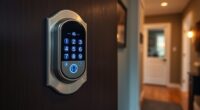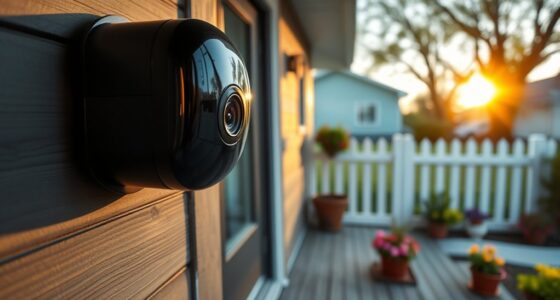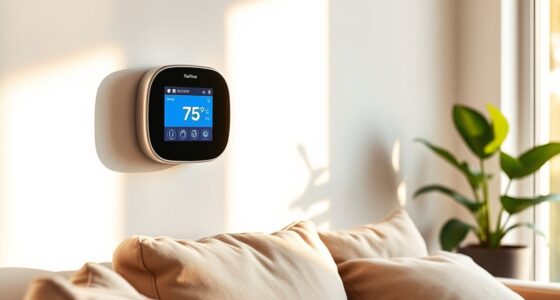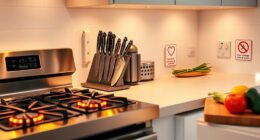Smart home tech now lets you monitor your health in real time with sensors that track essential signs, movement, and sleep patterns. Fall detection, emergency alerts, and environmental controls enhance your safety and comfort. Medication reminders and chronic disease management tools support your well-being daily. Indoor air quality monitors ensure a healthy environment. Many features respect your privacy, but understanding how to use them best can make a difference—keep exploring to learn more.
Key Takeaways
- Wearable and contactless sensors continuously track vital signs like heart rate, blood pressure, and oxygen levels for health monitoring.
- Smart home devices detect falls, unusual activity, and environmental changes to ensure safety and prompt emergency responses.
- IoT-enabled medication dispensers and sleep monitors support chronic disease management and improve sleep quality.
- Data security measures such as encryption, anonymization, and user consent protect sensitive health information.
- Automated environment controls and telehealth platforms create healthy, personalized living spaces with seamless device integration.
How Smart Sensors Track Vital Signs and Movement

Smart sensors play a crucial role in monitoring your health by continuously tracking vital signs and movement without interrupting your daily routine. Passive infrared sensors detect your presence and monitor movement, providing data on activity levels and location inside your home. AI security advancements ensure these sensors operate safely and reliably. Wearable devices and contactless environmental monitors measure vital signs such as heart rate, blood pressure, and oxygen saturation, giving you real-time health insights. These sensors work seamlessly, silently collecting information on your physiological parameters and motion patterns. Location-tracking sensors like GPS or indoor positioning systems further analyze movement and spatial occupancy. The data collected is stored and processed using platforms like SQL, MATLAB, or Python, helping identify health trends and detect unusual activity promptly—continuous monitoring enhances early detection and intervention. Additionally, improved data privacy measures help protect sensitive health information from unauthorized access. Integrating health data analysis capabilities allows for more comprehensive assessments of your overall well-being, facilitating proactive health management—all while remaining unobtrusive and easy to integrate into your daily life. Modern sensor networks also enable real-time alerts to notify you or caregivers immediately in case of health anomalies, ensuring prompt action when needed.
Enhancing Safety With Fall Detection and Emergency Alerts

Falls can happen unexpectedly, especially among older adults or those with mobility challenges, making timely assistance essential. Smart home safety integrates fall detection sensors that automatically alert caregivers or emergency services within seconds of a fall. Affiliate commissions are earned when readers make qualifying purchases of these devices through links, supporting the website’s content. Motion sensors and accelerometers help identify unusual activity patterns, reducing false alarms and ensuring help arrives when needed. Additionally, some systems incorporate real-time monitoring features that provide ongoing health insights to caregivers and users alike. These features may also include customizable alerts, allowing users to modify notification preferences based on individual needs. Emergency alerts systems, easily activated through voice commands or buttons, allow you to summon assistance quickly. These features enhance health monitoring by providing immediate responses, which can decrease injury severity and response times. Incorporating alert customization can further improve the effectiveness of emergency notifications by tailoring alerts to specific circumstances or user preferences. By combining fall detection with emergency alerts, smart home technology creates a safer environment, giving you peace of mind that help is always accessible in critical moments.
Monitoring Sleep Patterns and Promoting Restful Nights
By leveraging sleep monitors and sensors, your smart home can track your sleep duration, quality, and interruptions in real time. These devices gather detailed sleep patterns, helping you understand how well you rest each night.
Smart sleep trackers and smart mattresses monitor physiological signals like heart rate and breathing, providing insights into your sleep quality.
Automated lighting and temperature controls create the perfect environment by adjusting light levels and microclimate conditions, making it easier to fall asleep and stay asleep.
Integration of calming sounds, blackout curtains, and gentle alarms supports healthy sleep hygiene, promoting relaxation and a more restful night.
With this technology, you can identify issues like insomnia or sleep apnea early and make adjustments to improve your overall sleep health.
Supporting Chronic Disease Management at Home

Smart home tech makes managing chronic illnesses easier by monitoring essential signs like blood pressure and glucose levels in real time. Devices such as medication reminders and pill dispensers help you stay on track with treatment plans, reducing the risk of complications. With remote health communication and continuous data collection, you and your caregivers can act quickly if health issues arise. Incorporating self-reflection practices can further enhance your understanding of health patterns and promote proactive management.
Vital Sign Monitoring
Have you ever wondered how technology can help manage chronic diseases right from the comfort of your home? Essential sign monitoring uses IoT devices and wearable biosensors to track measures like blood pressure, heart rate, oxygen saturation, and glucose levels in real time. Low light office plants, such as the Snake Plant or Pothos, can be placed nearby to improve indoor air quality and create a calming environment that supports overall well-being. This remote monitoring provides critical health data, enabling early detection of issues before they worsen. Color accuracy, ensuring that health data displays correctly on various screens, is vital for accurate interpretation of vital signs. Centralized home health systems integrate multiple sensors, giving you and your healthcare team a thorough view of your condition. Scientific research into psychological and neurological aspects of dreaming suggests that understanding subconscious processes can enhance dream interpretation and self-awareness. Studies show that continuous vital sign tracking can reduce hospital visits by allowing timely interventions. Many advanced devices also feature alerts and automatic notifications when vital signs go outside safe ranges, supporting proactive health management and helping you stay in control of your chronic conditions. Additionally, advancements in wearable sensor technology have made continuous monitoring more comfortable and unobtrusive for daily use. Moreover, ensuring proper data security and privacy is essential to protect sensitive health information during remote monitoring.
Medication Adherence Support
Managing medications at home can be challenging, but smart home technology offers effective solutions to support you. IoT-enabled devices like connected pill dispensers and reminder apps improve medication adherence by ensuring you take the right doses on time.
Automated dispensers with voice recognition and facial identification verify your identity and dispense medications accurately. Integration with health monitoring sensors allows real-time tracking of medication effects, such as blood pressure or glucose levels, enabling personalized care tailored to your needs. Personalized care can be further enhanced by analyzing data trends to optimize treatment plans.
These smart systems send alerts if doses are missed or overdue, helping reduce hospitalization risks. Studies show that using these medication adherence tools can boost compliance rates by up to 30%, making managing chronic diseases more effective and less stressful at home. Celebrity transformations often highlight how adopting innovative health management tools can lead to positive lifestyle changes, inspiring you to stay on track with your medications. Additionally, incorporating digital literacy programs can empower seniors to confidently utilize these advanced devices for better health outcomes.
Furthermore, integrating remote monitoring capabilities allows healthcare providers to oversee patient health data remotely, improving overall care coordination.
A focus on Lifespan development can help in designing user-friendly features suitable for all ages, ensuring everyone benefits from these technological advancements.
Remote Health Communication
How can you stay connected with your healthcare team without leaving home? Remote health makes this possible through smart devices and telehealth platforms that facilitate virtual consultations and real-time monitoring.
Connected sensors and wearables transmit essential sign data—like blood pressure, glucose levels, and oxygen saturation—directly to your medical team, supporting chronic disease management. Smart device interoperability ensures that different systems work seamlessly together for more accurate data collection.
Voice-activated systems and AI assistants help those with mobility or sensory impairments access health info, medication reminders, and emergency help remotely.
These systems automatically alert caregivers about critical changes in your vital signs, reducing the need for frequent in-person visits. Incorporating real-time data transmission technologies ensures that health information is continuously updated and immediately available to healthcare providers.
By integrating smart devices with telehealth, you assure continuous, unobtrusive communication, making managing chronic conditions more efficient and less stressful.
Additionally, cybersecurity measures help to protect sensitive health data during transmission and storage, maintaining patient privacy and data integrity.
Real-time monitoring can also help in detecting early warning signs, allowing for timely interventions that prevent complications. For example, continuous glucose monitors can alert diabetic patients and their healthcare teams to dangerous fluctuations before symptoms appear.
Furthermore, the use of data analysis tools can assist providers in identifying trends and adjusting treatment plans more accurately.
Remote health truly keeps you connected and in control of your well-being.
Ensuring Clean Indoor Air and Environmental Quality

Maintaining clean indoor air is essential for your health, especially since pollutant levels inside can be two to five times higher than outdoors. Smart indoor air quality systems use air pollution sensors to detect pollutants like VOCs, allergens, and fine particles, helping you identify potential hazards.
Automated filtration systems adjust filters and airflow in real-time, ensuring ideal indoor air quality. UV disinfectant lights and advanced filtration technologies actively eliminate germs, bacteria, mold, and viruses, reducing health risks.
Continuous environmental monitoring offers ongoing insights into indoor pollutant levels, enabling timely adjustments. By integrating these smart technologies, you create a healthier home environment, supporting better respiratory health and overall well-being while reducing exposure to indoor pollutants.
Encouraging Healthy Habits Through Automation and Reminders

Smart home technology actively promotes healthier lifestyles by automatically sending reminders for medication, hydration, and exercise, making it easier to stay on track. With automation and sensors, your system detects inactivity, sleep patterns, and daily routines, then delivers personalized prompts to encourage healthy habits.
These reminders can include:
- Alerts to stand or move after prolonged sitting
- Voice assistant prompts for hydration or stretching
- Medication reminders tailored to your schedule
This integration ensures you maintain consistency, reducing risks associated with inactivity or missed doses. By leveraging automation and real-time data, smart home systems help you develop sustainable habits effortlessly.
Staying healthy becomes seamless when reminders are timely, personalized, and integrated into your daily environment.
Overcoming Challenges and Ensuring Data Privacy in Smart Health Systems

You need to implement strong data security protocols like encryption and access controls to protect sensitive health information.
Privacy preservation strategies, such as anonymizing data and managing user consent, help maintain trust.
Ethical data management guarantees compliance with regulations and safeguards user rights in smart health systems.
Data Security Protocols
Effective data security protocols are essential for protecting health information in smart home systems, especially as cyber threats become more sophisticated. You must implement strong measures like encryption, such as AES-256, to keep health data safe during transmission and storage.
Regular security audits, vulnerability assessments, and timely software updates help identify and address risks before they escalate. Incorporating privacy-by-design principles means collecting only necessary data, using it transparently, and storing it securely to comply with regulations like GDPR and HIPAA.
To strengthen security, consider:
- Multi-factor authentication and biometric access controls
- Robust security protocols for data protection
- Transparent data policies and user consent procedures
These steps ensure your smart health system maintains privacy and shields sensitive health data from breaches.
Privacy Preservation Strategies
To guarantee data privacy in smart health systems, implementing robust privacy preservation strategies is essential, especially as healthcare data becomes more vulnerable to breaches. You should use privacy-enhancing techniques like data encryption and anonymization to protect sensitive information.
Federated learning enables your devices to collaborate without sharing raw data, reducing privacy risks.
Edge computing processes data locally on your devices, minimizing transmission over networks and enhancing privacy.
Ensuring strong user consent frameworks clarifies how your data is collected, used, and shared, building trust.
Regular security audits, firmware updates, and user authentication protocols are also critical to prevent unauthorized access.
Ethical Data Management
Ensuring ethical data management in smart home health systems involves steering complex challenges to protect user privacy and uphold trust. You must prioritize data security with strong encryption and anonymization techniques to prevent breaches.
Clear data governance policies—like obtaining explicit user consent and providing transparent privacy notices—are essential to respect your privacy rights.
Regular security audits and real-time access logs help identify vulnerabilities before they become issues.
To maintain ethical standards, you also need to address challenges such as data bias and user control, ensuring equitable and privacy-respecting health monitoring.
- Implement robust encryption protocols to safeguard sensitive information
- Obtain clear, informed consent for data collection and sharing
- Establish transparent data governance policies for user trust
Frequently Asked Questions
What Is a Smart Health Monitoring System?
A smart health monitoring system keeps track of your essential signs and health data through connected sensors, devices, and software. It collects information like heart rate, sleep patterns, and activity levels in real-time.
You can receive alerts about potential issues, and healthcare providers or family members can monitor your health remotely. This setup helps you manage chronic conditions, detect problems early, and stay healthier at home.
How to Make an Iot Based Health Monitoring System?
Did you know that by 2025, over 75% of healthcare data will be generated by IoT devices? To create an IoT-based health monitoring system, start by choosing suitable sensors like vital signs monitors and environmental sensors.
Then, set up secure wireless communication, connect devices to a central platform, and develop an intuitive interface. Focus on scalability, privacy, and interoperability to guarantee reliable, effective health monitoring.
What Is Home Health Monitoring?
Home health monitoring means you use sensors and connected devices in your house to keep track of your health. These tools monitor essential signs, activity, sleep, and environmental factors in real-time.
You get continuous updates that help spot issues early and support your independence. By using motion sensors, wearables, and environmental monitors, you can better manage your health and share data with your healthcare team for personalized care.
What Is Smart Home Monitoring?
Imagine your home as a vigilant guardian, always watching over you. Smart home monitoring uses interconnected sensors and devices to keep an eye on your health and environment. It detects essential signs, activity, and hazards without you lifting a finger.
With this technology, you get early alerts, support for medication, and safety features, making your home a proactive protector that helps you stay healthy and secure every day.
Conclusion
So, next time your smart home gently nudges you to breathe deeper or reminds you to stand up, just imagine it as your overbearing but well-meaning health coach with a penchant for spying. It’s like having a tiny, vigilant nurse living in your walls—except with fewer scrubs and more sensors. Embrace the chaos, trust the tech, and remember: your smart home’s watching, so you might as well get healthier while it does.









